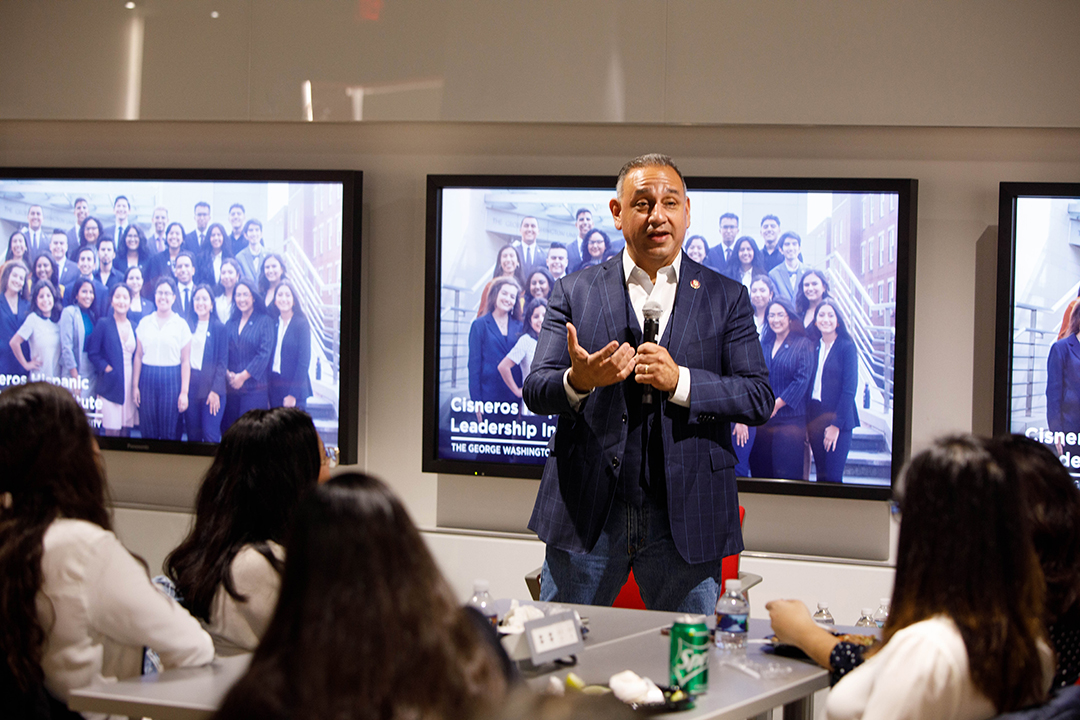By B.L. Wilson
All too often stories about the Latinx community in the media represent them as a monolithic voting bloc or as immigrants trying to cross the border, said Barbara Benitez-Curry, assistant professor and studio manager in the George Washington University School of Media and Public Affairs (SMPA).
“We just frame stories through this very tight lens, giving the impression or narrative to non-Latinos that there’s this browning,” said Ms. Benitez-Curry, who moderated the discussion on media stereotypes. “There’s actually been stories titled the browning of America,” she said. “How can we shift the narrative?”
In recognition of GW’s Latinx Heritage Celebration, SMPA and the Cisneros Hispanic Leadership Institute co-sponsored a panel discussion titled “Boxed In: Breaking Stereotypes of Latino Identity in Journalism” Thursday evening. SMPA Director and professor Silvio Waisbord and Cisneros Institute Executive Director Elizabeth Vaquera, an associate professor of sociology and public policy and public administration, joined students at the hybrid event in a GW conference room.
Online with Ms. Benitez-Curry were three prominent journalists: broadcast pioneer Ray Suarez, who has worked for decades in journalism; Rebecca Aguilar, the first Latina president of the Society of Professional Journalists; and Lori Lizarraga, an Emmy award winning freelance journalist who recently made national headlines when she criticized a Denver television station for firing her and two other Latina reporters.
Ms. Lizarraga led off the discussion by explaining the issues surrounding her dismissal by television station KUSA in Denver, Colorado.
“Diversity is a complicated thing. It is not enough to hire Black and Brown people and say done, check the box and move on,” she said. “Culturally, we have to acknowledge that what we bring to the table is not in fact bias but a lot of value and worth.”
When that doesn’t happen, she said, you lose the trust of people in the Latino community. Her complaints did lead to ending the use of the term “illegal immigrants” at TEGNA, the station’s parent organization, and scores of television stations around the country.
According to Mr. Suarez, conditions for Hispanics in mainstream media have not changed that much. “Improvement has been very slow, very fitful and episodic,” he said. “The numbers are still very discouraging for [the Hispanic] population that is approaching one out of five Americans, 62 million people. The numbers are in aggregate about the same place they were 20 years ago.”
He blamed the low numbers of Latinos in news organizations, in part, on the changing nature of the business that has been dramatically altered by technology and has yet to figure out how to monetize the internet.
“It is hard to diversify a shrinking workforce,” he said, noting a 57% decline in newspaper jobs.
Media can change the narrative about Hispanics, he said, by telling stories that reflect the lives that people are living whether they’re about real estate taxes or utility bills.
“They don’t have to be Latino stories, they just have to be stories that reflect the place and tell a more complicated, more nuanced story about events that affect everybody,” he said. “When someone speaks for everyone, that person is a white person and that’s the way we have done news in this country. We have to get away from that.”
He said representation is good, but when reporters pitch stories they should realize they can also brand themselves “as ambitious professionals who also want to be called upon to do the lead story, who want to be sent on the road and to get the big interviews.”
Ms. Benitez-Curry asked how to get news managers and editors who are usually white to understand that.
Ms. Aguilar said she tells news managers, “Examine your friends. How many are Latinos? How many of your besties are Latinos because if there isn’t a Latino in there, you’ve got problems.”
“Think about who are your college friends right now,” she said to students. “Are they diverse? I go to parties when I’m invited by other journalists, and I’m the only Latino, and I literally will tell my friends, ‘Am I the only Latino you know?’ And they laugh. They joke about it, but seriously.
“Sometimes it is just having a conversation with your boss… ‘How can we keep covering the same stories about immigrants crossing the Rio Grande? What about the immigrants that started as undocumented and now are millionaires in Dallas?’” she said. “It is making the effort to open their minds. It gets frustrating. It gets tiring. But you cannot give up.”
Mr. Suarez encouraged students in journalism to pursue jobs that put them on the managerial track, as desk editors, assignment editors and as producers as opposed to the frontline on air jobs where they may be steered because “it is a way for a station to look diverse when it is not.”
Ms. Aguilar reminded them, “Journalism is a calling. Be the best journalist you can be. Break stories. Have sources. Become a leader in an organization.”



